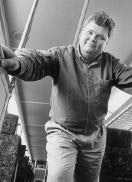IT WAS A BOARD MEETING much like dozens of others at Sound Transit headquarters. The primly professional Sound Transit executive staff gave their soothingly bland PowerPoint presentations, full of pie charts and bullet points. Their voices went on in the same instructive monotone about “outreach to stakeholders” and how confident they were that their light rail project could be completed “on schedule,” the budget was “adequate,” their projections “conservative,” the project “affordable.” It all seemed so reasonable.
The only differences last week were that a few faces were new (Sound Transit’s light-rail director has been replaced) and the staff was now informing its audience that all those previous times the same assurances had been given in that same highly credible tone of voice, the information was actually not very credible at all. All those times now turned out to be “honest mistakes,” excessive “optimism,” and “errors in judgment.”
The Sound Transit staff had now determined that light rail is going to cost $3.6 billion—a billion dollars more than voters were promised in 1996—and take three years extra to complete. The 22-mile light-rail line, which includes a very expensive tunnel connecting the U District, Capitol Hill, and downtown, was supposed to be running by 2006. To come up with this new, more realistic budget, Sound Transit and its consultants “worked line by line to make sure all the costs were captured,” stated Bob White, Sound Transit’s executive director. (And before, they used to skip a line or two, just for fun?)
There was plenty of outraged public testimony at the overflow meeting, mostly from longtime Sound Transit opponents. But the board members themselves gave Sound Transit a pretty easy time. Ironically, it was board member Greg Nickels, a King County Council member and one of the most dogged light-rail boosters, who let his impatience show. “Light rail,” he pointed out, “is not an end in itself. The end is to improve transportation. . . . What opportunities do we have to look at non-tunnel or non-light-rail alternatives?”
By contrast, board member and King County Executive Ron Sims said in an interview that he’s “still committed” to light rail. “At a certain point, we have to start acting, doing something,” he said. “In all the polls, voters are saying ‘build it.’ This has become a litmus test as to whether government can get something done.”
In the end, the board made no move to step back from light rail and apparently never will—despite the grave misgivings of many environmentalists, transit planners, and downtown merchants. Instead, board members spoke again about the need to not miss out on the $500 million pot of federal money that’s been offered if they press ahead.
It all felt both strangely familiar and grimly portentous. At a news briefing to announce the stunning new projected price tag for light rail, Sound Transit’s new chief operating officer, Joni Earl, declared, “This is as bad as it’s going to get.” But since the project is eight years from completion, already 50 percent over budget, and not a spade of dirt has been turned, it was hard not to imagine the many, many board meetings to come—featuring new, ever more contrite and reassuring Sound Transit faces, annually informing the board that while “mistakes were made,” information was withheld from the public, and costs have skyrocketed, the worst, “quite frankly,” is now over.








